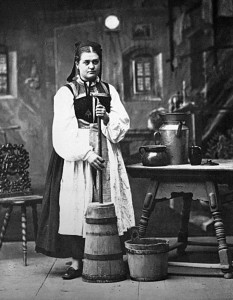
You’ve seen it as a youngster. A demonstration in which cream is turned into butter by whipping, perhaps by an electric mixer, perhaps using a hand mixer. How is it possible?
Cream is a suspension of fat globules spread throughout a water-based or aqueous solution—a solution that contains water-soluble substances. Preventing the tiny fat globules from joining together—coalescing—is a kind of membrane surrounding each one, called a milk fat globule membrane (MFGM).
Butter? MFGM Composition and Structure
This membrane is composed of proteins, enzymes, and lipids.¹ Actually, there are two layers that develop around each fat core—a phospholipid layer (developed at the time of formation) encased within a plasma membrane layer (formed at the time of secretion).² The combination is often referred to simply as the bilayer. These membrane structures as well as the underlying core, are clearly delineated in images displayed by Ref. 2.

Disrupting the Membranes
Now by mechanical agitation, or through freezing, it is possible to disrupt these membranes, allowing the fat cores in each globule to be set free. Then, as they come into contact with each other, these globules coalesce. The fat is largely solid fat—cream turns to butter! The aqueous component that remains after the fat coalesces is buttermilk.
Note: You might also enjoy Short, Medium, and Long Grain Rice Vary in Use and Starch Profile
References:
- NCBI PubMed: Milk fat globule membrane components–a proteomic approach
- NLM: NIH: Open Access Biomedical Research: Milk Fat Droplet Images

Those farmers did this even though they had no idea what was going on at a molecular level and it turned out perfectly. I love buttermilk and when I drink it I savor its flavor. It’s a time-honored tradition in my family.